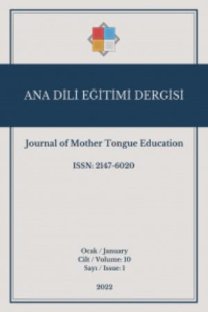Üniversite Birinci Sınıf Öğrencilerinin Elektronik Posta Yazma Becerilerinin Değerlendirilmesi
Evaluation of Electronic Mail Writing Skills of Freshman Students
___
- Aslan, A. (2016). Türkiye’de çocukların güvenli internet kullanımında 2010-2015 yılları arasındaki değişimler ve uygulamaların yansımaları.Erzurum: Atatürk Üniversitesi, Yayımlanmamış Doktora Tezi.
- Baron, N. S. (1998). Lettersbyphoneorspeechbyothermeans: Thelinguistics of email. Language &Communication, 18(2), 133-170.
- Bayır, E. A. (2014). Çevrimiçi öğrenme ortamlarında sohbet ve e-posta kullanımının öğrencilerin işlemsel uzaklık algılarına etkisi. Ankara: Gazi Üniversitesi, Yayımlanmamış Doktora Tezi.
- Bengshir, T. K. (2000). Devlet-vatandaş iletişiminde e-posta. Amme İdaresi Dergisi, 33(4), 49-61.
- Bradley, T. &Carvey, H. (2006). Essential computer security: everyone's guide to email, internet, and wireless security. Canada: Syngress Publishing.
- Chen, C. F. E. (2006). Thedevelopment of e-mail literacy: Fromwritingtopeerstowritingtoauthorityfigures.Language Learning &Technology, 10(2),35-55.
- Çakır, H. ve Topçu, H. (2006). Bir iletişim dili olarak internet. Erciyes Üniversitesi Sosyal Bilimler Enstitüsü Dergisi, 19(2), 71-96.
- Dabbagh, N., &Bannan-Ritland, B. (2005). Online learning: Concepts, strategies, and application. Upper Saddle River, NJ: Pearson Education, Inc.
- Eliçin, C. (2011). Thestrategies in requestsandapologies of Turkishfledstudents: A comparison of electronicmailsand DCT data. Unpublished Master Thesis. Boğaziçi UniversitySocialScienceInstitute, İstanbul.
- Erkan, D. Y. (2004). Efficact of cross-cultural e-mail exchangeforenhancing EFL writing: A perspectivefortertiarylevelTurkish EFL learners. Adana: Çukurova Teknik University, Unpublished Doctorate Thesis.
- Erkan, D. Y. (2013). Kültürler arası elektronik posta yolu ile yazışmanın İngilizce yazma becerisinde özyekinliğe etkisi. Çukurova Üniversitesi Sosyal Bilimler Enstitüsü Dergisi, 22(1), 25-42.
- Filippone, M., &Survinski, M. (2016). Theimportance of etiquette in schoolemail. AmericanSecondaryEducation, 45(1), 22-27.
- Güler, C. (2007). Uzaktan öğrenenlerin e-postayla etkileşime girme sıklıklarıyla yüz yüze ortamlarda iletişime girme isteklilikleri arasındaki ilişki.Eskişehir: Anadolu Üniversitesi,Yayımlanmamış Yüksek Lisans Tezi.
- Gürkaya, B. D. (1999). Using the internet andelectronic mail in writingclasses: A study on thereactionsandsuccess of preparatorystudents at Işık University. Ankara: Orta Doğu Teknik University, Unpublished Master Thesis.
- Hani, N. A. B., &Alghonaim, A. S. (2014). Theutilization of e-mail technology in developingwritingskillstofreshman EFL learners. InstructionalTechnology, 11(8), 43-53.
- Haşıloğlu, S. B. (1999). Elektronik ticaret ve stratejileri. İstanbul: Türkmen Kitabevi.
- Huang, E. Y. & Lin, S. W. (2014). How does e-mail useaffectperceivedcontrol of time? Information & Management, 51(6), 679-687.
- Lamb, S. E. (2006). Office e-mailsandvoicemessaging. Business &EconomicReview, October-December, 30-31.
- MEB. (2017). Bilişim teknolojileri ve yazılım dersi öğretim programı (Ortaokul 5 ve 6. sınıflar). Ankara: Millî Eğitim Bakanlığı.
- Munter, M., Rogers, P. S., &Rymer, J. (2003). Business e-mail: Guidelinesforusers. Business CommunicationQuarterly, 66(1), 26-40.
- Nawaz, W., Khan, K. U., & Lee, Y. K. (2016). A multi-userperspectiveforpersonalizedemailcommunities. ExpertSystemswith Applications, 54, 265-283.
- Nazari, B., &Niknejad, S. (2015). E-mail Writing: Providing Background Information in theCore of ComputerAssistedInstruction. Turkish Online Journal of DistanceEducation, 16(1), 193-211.
- Özbay, S. ve Akyazı, S. (2004). Elektronik ticaret. Ankara: Detay Yayıncılık.
- Shang, H. F. (2007). An exploratory study of e-mail application on FL writing performance. Computer Assisted Language Learning, 20(1), 79-96.
- Stockwell, G. &Levy, M. (2001). Sustainability of e-mail interactionsbetweennativespeakersandnonnativespeakers, ComputerAssisted Language Learning, 14(5), 419-442.
- Türk Dil Kurumu. (2011). Türkçe sözlük(11. Baskı). Ankara: Türk Dil Kurumu Yayınları. URL 1: https://wearesocial.com/special-reports/digital-in-2017-global-overview (Erişim Tarihi: 15.03.2017).
- URL 2: https://ttkb.meb.gov.tr/www/ogretim-programlari/icerik/72 (Erişim Tarihi: 18.06.2017).
- URL 3: http://mufredat.meb.gov.tr/ProgramDetay.aspx?PID=152 (Erişim Tarihi: 20.08.2017).
- URL 4: http://www.resmigazete.gov.tr/default.aspx (Erişim Tarihi: 07.10.2017).
- Zarepour, F., &Saidloo, M. I. (2016). An analysis of Iranian EFL learners’ English written requestive e-mails.
- Journal of Language Teaching and Research, 7(3), 579-585.
- ISSN: 2147-6020
- Yayın Aralığı: 4
- Başlangıç: 2013
- Yayıncı: Mehmet Kurudayıoğlu
Dördüncü Sınıf Fen ve Teknoloji Derslerinin Diyalojik Öğretim Açısından Analizi
Türkçe Öğretim Programlarında Bilimsel Süreç Becerisi Olarak “Gözlem”
Gökhan Haldun DEMİRDÖVEN, ALPASLAN OKUR
Ana Dili Öğretiminde Yapılandırmacı Hedefler Üzerine Bir Tasnif Çalışması
Dik Temel Yazı ve Bitişik Eğik Yazı Kullanımına Yönelik Sınıf Öğretmeni Adaylarının Görüşleri
SERDAR ARCAGÖK, Gizem KOBAK, MEHMET KAAN DEMİR, ÇAVUŞ ŞAHİN
Eğitim Fakültesi Öğrencilerinin Serbest Yazma Tutumlarına Dair Ölçek Geliştirme
Bilge BAĞCI AYRANCI, FAHRİ TEMİZYÜREK
Eğik El Yazısıyla Okuma Yazma Öğrenen Öğrencilerin, Eğik El Yazısına İlişkin Durumları
ÖZCAN PALAVAN, Necati GEMALMAZ
BAYRAM BAŞ, OSMAN TURHAN, FATMA KARACA TURHAN
Okuma Alışkanlığının Temel Eğitimden Ortaöğretime Geçiş (TEOG) Sınavına Etkisi
